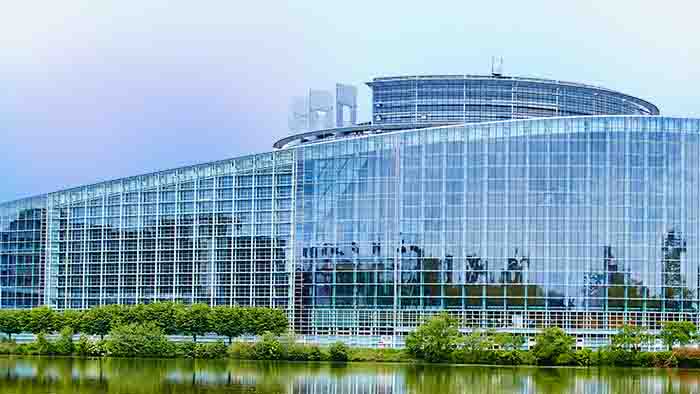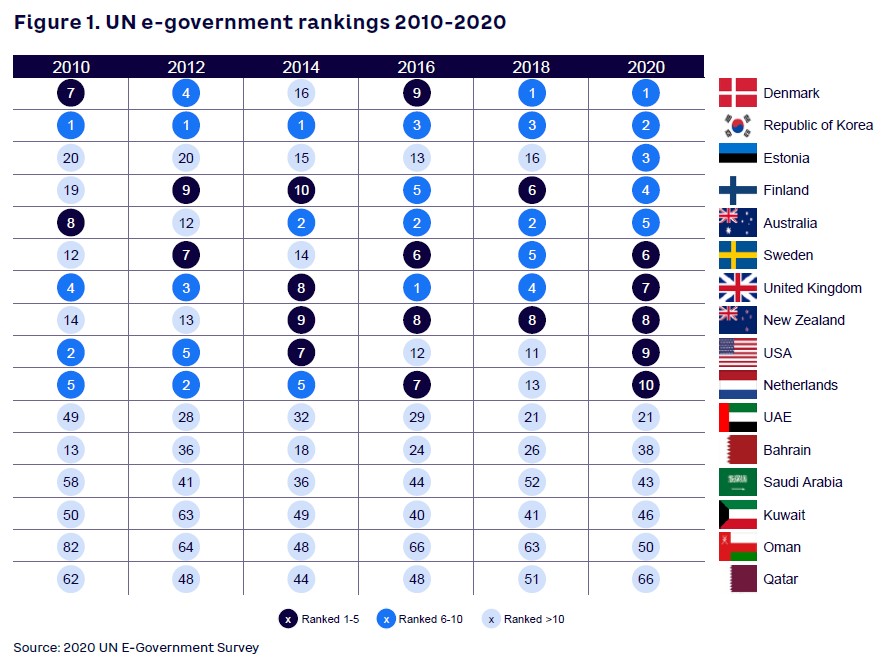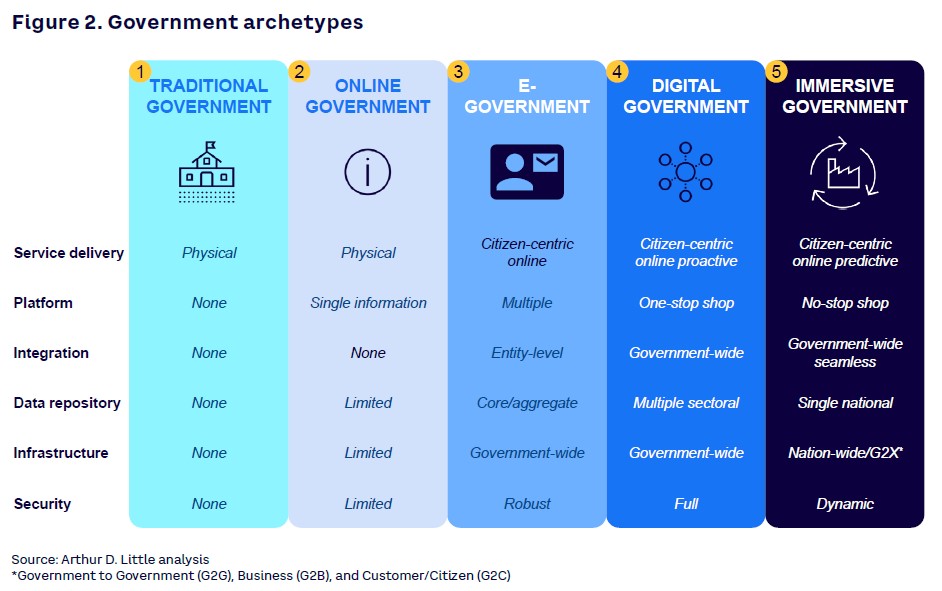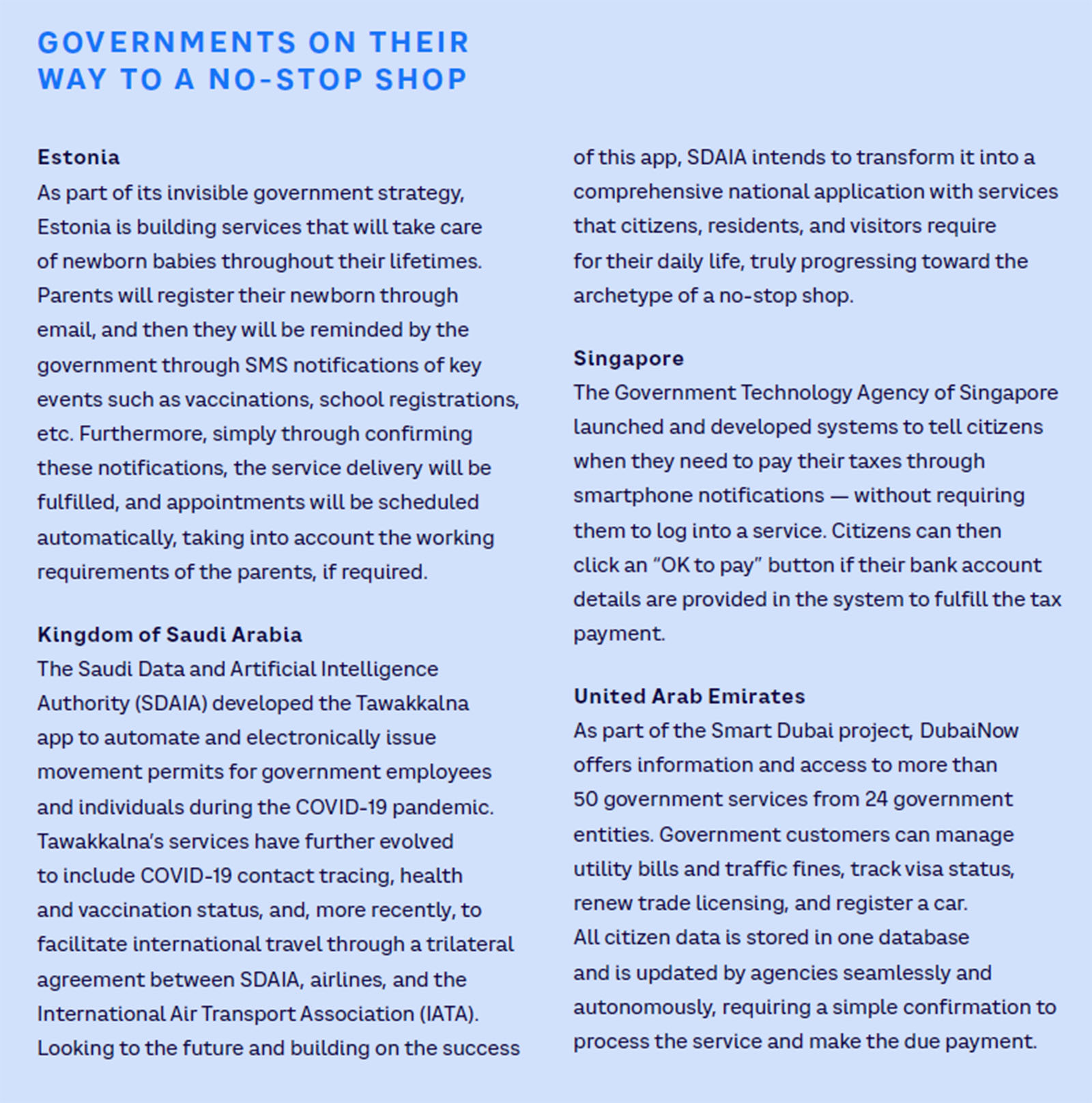
Winds of change
In a rapidly changing, digitally enabled world where citizens have become used to services only a click away, governments continue to struggle to keep pace despite significant advancements in e-government or, as it is more commonly known today, digital government. In the future, digital government will be a key enabler not only for the way governments improve service delivery to citizens but also in the way core government functions evolve around four core themes [1]:
- Governance and resilience. Protecting citizens and ensuring their peace and security within and beyond national borders. Digital government will enable governments to adopt a citizen-centric business model, provide efficient governance, optimize citizens’ trust, and encourage best-in-class participation and consensus building.
- Economy and society. Ensuring economic growth and social well-being for all citizens through a variety of services. Digital government will allow for a stable economic environment, top-quality public services, and easier ways of doing business, and will promote competitiveness.
- Environment and health. Preserving and enhancing the natural environment and citizens’ health. Digital government will enable environmental sustainability, sound waste management programs, reliable food and water supplies, and an all-inclusive and timely healthcare ecosystem.
- Future and progress. Understanding research, development, innovation, promotion, and adoption of future-oriented education. Digital government will help advance future-oriented national capital, entrepreneurship, localization, and a world-class education system.
In progressing across these four themes and providing more personalized services to constituents, most of the leading digital government countries in United Nations (UN) e-government rankings (by the UN Department of Economic and Social Affairs) have been jostling for a top 10 position over the last decade. Gulf Cooperation Council (GCC) nations have made strides in this race, yet they can do more to reach their full potential on the digital government evolution journey. These global and regional evolutions are shown in Figure 1.
Digital technologies steering the journey
In many ways, the COVID-19 pandemic has been a catalyst for change in the way governments offer services to their citizens. It has highlighted in real-life terms the importance of digital tools, platforms, and services for a nation to be resilient and adaptable. The transformation to digital government is simply a journey steered by the continuous advancements in digital technologies and data analytics, which present innovative ways for both private and public enterprises to conduct business and deliver services. Examples of such key digital technologies include but are certainly not limited to:
- Connectivity and 5G infrastructure. As key to realizing any digital transformation, leading Organisation for Economic Co-operation and Development (OECD) digital government countries have seen mobile broadband subscriptions jump from 32 per 100 inhabitants in 2009 to nearly 113 per 100 inhabitants in 2019 [2]. During the same time period, the average mobile data usage quadrupled. With people and devices becoming increasingly interconnected, 5G technology will increase the ease of sharing data, data transfer rates, and the volume of data, thus giving governments access to an unprecedented amount of real-time data, which can be analyzed to better serve citizens’ needs. 6G, the successor to 5G, is also already on the radar screen of telecommunication companies and standards bodies, and will be significantly faster, making data exchange and service delivery even more expeditious.
- Robotic process automation (RPA). RPA can be thought of as software robots, which can be used to standardize and automate repeatable government processes. This method of automation can enable tasks to be performed faster, accurately, and in a standardized manner, thus improving overall customer satisfaction and freeing up human resources for other critical tasks. RPA is being widely deployed across applications in leading digital governments.
- Machine learning (ML) and artificial intelligence (AI). As of late, governments are using data analytics/ML to extract insights related to the needs and behaviors of their citizens, design better systems and processes, allocate resources where needed most, and improve efficiencies. In the years to come, governments will be able to leverage the full power of AI to automatically predict and deliver on the needs of their citizens without any action required by the citizens themselves 3truly a real-time responsive and immersive government service delivery experience.
- Citizen digital identity. A digital identity provides a secure means to prove an individual’s identity via any government digital channel that is available to citizens. This is critical, particularly for inclusion and access to government services. Digital identity ecosystems are quickly evolving and allowing governments to be more responsive to citizens regardless of the channel used to access digital government services.
Prevailing digital government challenges
Although the aforementioned digital technology advancements will allow future-oriented governments to be more connected, robust, efficient, proactive, and provide interaction-less service delivery, many governments still face challenges to build momentum toward a truly immersive digital government service delivery status. These challenges include:
- Inadequate cybersecurity measures. With constant and evolving cybersecurity threats, governments need to constantly review and enhance their cybersecurity measures to protect digital infrastructure, data, and platforms.
- Underdeveloped data protection laws. Data protection laws that are underdeveloped need either to be developed and enacted or reviewed and improved to ensure proper and legitimate use of personal data and, in turn, support trust building with citizens.
- Outdated organizational structures. With new disruptive digital business models becoming more prevalent across governments, existing organizational structures must be reviewed and updated to empower agile and private sector–friendly operating models.
- Scarcity of resources and dated skillsets. With prosperity in the private sector, governments need to reconsider their employment value proposition and foster capabilities development to support modern digital technology–enabled transformation.
- Poorly articulated strategies. To be effective and realize the full value potential, digital transformation strategies must be built on measurable objectives[3], allowing governments to properly gauge digital service delivery and, in turn, performance maturity.
Risks of government inaction remain great
Governments that do not address the previously mentioned challenges will be unable to evolve their digital government services to meet the increasing needs of their citizens, and consequently risk the following:
- Becoming irrelevant in the global drive to modernize and digitally transform governments, when compared to leading digital government nations.
- Citizens and businesses becoming less engaged or even fully disengaged from interacting with governments.
- Lagging in the digital and data regulatory space, thereby preventing citizens, businesses, and even governments themselves from realizing their full digital transformation potential.
- Promoting a work environment that is not commensurate with the expectations from a digitally enabled government —not to mention sustainable —in the long term.
- Advancing a weak digital economy infrastructure that will lead to citizens and businesses becoming less productive when compared to their peers in leading digital government nations and, hence, to fewer national development opportunities.
To mitigate these risks, governments must develop bold strategies with clear objectives, new ways of working with the right skillsets, and transformative service delivery models with the proper and secure enablers. By doing so, governments will truly advance and become members of the elite club, the government of the future.
Evolving to government of the future
There are three key areas where governments should focus to enact change, allowing them to evolve toward a government-of-the-future status. First, governments must develop bold strategies stewarded by strong leadership. Second, governments must adopt new ways of working, requiring an update to government policies, a new generation of public servants, and an agile working environment. Finally, the way in which governments interact and offer services to citizens and businesses must progress in a transformative manner from a “one-stop shop” delivery model to a “no-stop shop” delivery model.
1. Bold strategies and leadership
Leading digital government nations have delivered on ambitious strategies with clearly defined, measurable objectives and responsibilities. For example, the UK government, as part of its digital strategy, has stated that “All departments handling over 100,000 transactions each year will redesign services” — a clear, measurable objective. In the GCC, the UAE Digital Government Strategy 2025 also has clearly defined KPIs with ambitious targets (e.g., to have 100% of its services digitized by 2023).
It is pertinent that if governments wish to develop toward the government of the future, they will require an ambitious strategy with clear objectives that can be measured and tracked. However, strategies and objectives alone will not be enough. They will also need to identify and promote new digital age government leaders who can understand the value of digital government and educate internal stakeholders as well as the general public on its benefits, resulting in timely buy-in from both the internal organization and the external public. These efforts should be combined with a roadmap with clear priorities, allowing immediate action to be taken and momentum to be built.
2. New ways of working
Today, most governments operate much the same as they have for the last 100 years. Rigid organizational structures together with bureaucratic processes lend themselves to ministries or departments working in silos with little room or interest for collaboration. Public servants of the past were attracted to government positions because those positions offered job security, set working hours, and required little technical know-how. Traditional government structures, processes, and mindsets worked well in the pre-digital era, but today they are not able to keep up with the rapid pace of a developing world. To successfully operate in a digital world and to meet citizens’ and businesses’ evolving expectations, governments must transform across three dimensions.
Digital-centric government frameworks, policies, and governance models
Laying a solid foundation to build the government of the future will require rethinking of current government frameworks, policies, and governance models to create an integrated and congruent approach to a digital government:
- Frameworks should be designed to enable: (1) a digital-by-default or digitally native mindset; (2) government as a platform that allows collaboration between various ministries, departments, and other entities; and (3) a one-time data entry principle, meaning citizens and businesses have to provide their data only once for all government dealings.
- Policies must enable accelerated adoption of digital services, both on the side of citizens and businesses as well as on the side of government organizations and employees. More importantly, policies need to be designed in a way that encourages transparency and input from citizens and businesses to build trust, a fundamental requirement for the government of the future.
- Governance models should ensure ongoing compliance by government organizations, quality of service delivery is being met, and a solid foundation for continuous improvement is established based on feedback from key milestones.
Next generation of public servants
Public servants will play a crucial role in the success of the government of the future, and therefore governments will need to cultivate the next generation of public servants. This next generation will need to challenge the traditional status quo along three aspects. First, public servants must develop a citizen-centric mindset as a service provider as opposed to the traditional “approver” mindset. Second, HR policies must be redesigned so that government roles have clear objectives, KPIs, and other metrics to foster accountability, stepping away from the traditional “job for life” model, and moving toward a more generalist role for public servants. Third, governments must rebrand themselves, design roles with career progression to attract the required talent for the digital age, and rethink ways of incentivizing talent given strong competition from the private sector. This will require a new look at the public service cadre construct, salary scales, assessment models, and career progression.
Agile and flexible working
To be successful, governments will have to borrow working styles from leading disruptive sectors, such as the technology sector. Working in an agile and flexible way will allow governments to keep up with the rapidly changing world, develop services that meet citizen and business needs quickly, and even stay ahead of the curve. Facilitating such a working style will require self-governing multidisciplinary teams that are tasked with a problem but given the freedom to solve it by working closely with external and internal domain experts and even customers (citizens, businesses, or civil servants). This could be achieved through developing a somewhat decentralized, holacratic management structure within government organizations, reducing the often heavy hierarchal management construct most governments possess. Such a new way of working or business model can be further reinforced through the effective participation of the private sector in the government’s operation and service delivery functions. Today, in many countries across the globe and in the Middle East in particular, public-private partnerships (or PPPs) are becoming increasingly common, bringing the best of the two sectors together to operate government assets and serve the general public and business community.
3. Transformative service delivery model
Governments all over the world are changing the way they interact with citizens and businesses and the ways they provide services to them. Throughout history and even for some today, it is common for government services to include lengthy forms, long waiting periods, slow processing times, physical presence, and other problematic issues that make it cumbersome for citizens to receive their rightful services with the expected quality and within the shortest time period.
Service delivery can be defined as any kind of contact with the public administration where citizens or businesses provide specific data and anticipate that the government will fulfill its obligations in processing this data for a particular needed service. The government’s customers usually expect an effective, predictable, reliable, and customer-friendly delivery. However, that is not the case in many governments due to several factors associated primarily with the level of integration of technology and enabling infrastructure within the public sector and platform interfaces between the public sector and its customers, be they citizens or businesses.
Governments have grown and developed throughout history, learning from their past and growing toward the future. Currently, the future seems to be linked to the development of advanced digital technology applications that increase efficiency and effectiveness and radically change the way one interacts with public systems. Each government system adopts a particular archetype that fits with its surrounding environment. However, some models grow and progress into future advancement while others remain stuck in the past, struggling with a variety of obstacles.
Due to this evolution and integration of modern technology, today’s governments can be classified into five main archetypes:
- Traditional government
- Online government
- E-government
- Digital government
- Immersive government
Each archetype category represents a government’s positioning across six key dimensions: (1) service delivery, (2) platform, (3) integration, (4) data repository, (5) infrastructure, and (6) security, as delineated in Figure 2.
Traditional government archetype
Mainly seen as a physically dominant model, the traditional government archetype is the oldest archetype. In it, both customers (citizens or businesses) and government clerks need to be physically present at a building or location at a specific department for a service delivery request to be submitted and then, after other department visits, fulfilled. This archetype lacks in platform, integration with other entities, data repository, infrastructure, and security. No technology adoption is seen at this level.
Online government archetype
Although still requiring a physical location, the online government archetype initiates the uptake of technology through a single information platform. Government-related procedures and statements can be accessed through an online portal that displays the needed information. There is still no level of integration within governmental and public departments, with limited data repository, infrastructure, and security systems that most likely run on legacy systems that were in use before the creation of the World Wide Web.
E-government archetype
The uptake of technology as well as the rollout of fiber networks and the improvement of broadband Internet connections has probably made the e-government archetype the most common in various countries around the world. Service delivery has evolved from requiring physical presence to applying a citizen-centric online approach to increase accessibility and convenience. To do so, multiple platforms exist to display different yet specific government information but also to provide the added advantage of submitting service delivery applications, attending to tax claims, and processing legal paperwork, and so forth, online.
A key element that makes this possible is the integration level across public entities. Data transmission and sharing is reciprocated across departments, with minimal levels of human intervention. Sharing such a large amount of data specific to each citizen or enterprise requires a core aggregated data repository for storage and easier access. The means to establish a strong connection between citizens, data, and the public sector requires a government-wide, capable infrastructure across all government organizations. This reduces confusion and duplication. Finally, a robust security system protocol is needed to prevent any breach of information.
Digital government archetype
The next level of development for government archetypes focuses on the digitalization of services from the citizens’ or businesses’ experience perspective, where citizens or businesses expect governments to act proactively by initiating appropriate government services themselves. Citizens or businesses can also seek out information and data on a single unified platform — a one-stop shop that combines all government information, requests, and services. This is enabled by government-wide integration across all government organizations and a multiple sectoral data repository system. The digital government archetype thrives on a government-wide infrastructure and a full security system spanning physical and cybersecurity measures.
Immersive government archetype
The ultimate archetype focuses on a citizen-centric online predictive service delivery model that transcends a one-stop shop platform to a no-stop shop — one that requires no action or form to be filled out by either a citizen or business to receive government services (see box on next page). AI and ML technologies are highly leveraged in this archetype. Data storage is integrated seamlessly across the government organizations with a single national data repository built with high interoperability in mind. This archetype is complemented by a nationwide/G2X infrastructure and a dynamic, always current, security system for data privacy, management, and authentication.
Conclusion
On the road to the government of the future
In a world that is changing so rapidly and on a daily basis, it is likely that the government of the future will not be an end state but rather a continuously changing ecosystem that must evolve with the needs of its customers, be they citizens or businesses. Through bold strategies, strong leadership, new ways of working, and changes in the way services are delivered, governments can start to lay a solid foundation for the future.
Governments on this journey still face significant challenges that they must overcome. Citizens have become frustrated by reactive and repetitive government services in which most services are still initiated by citizens, even with a one-stop shop model, and at times require entering data for each application. Data security is a concern as it becomes more difficult to keep data secure as well as to ensure customer or constituent privacy is always maintained. Data integration presents a challenge, as alignment of different data models, semantics, and legacy systems into new architectures requires a large amount of effort and investment in infrastructure. Advancing toward a no-stop shop delivery platform requires developing a trusted relationship between customers and the government built on transparency, data security, and privacy management.
Despite these challenges —, and considering the benefits proven by leading digital government nations, the future potential of a full immersive government, and the risks of maintaining the status quo —, government inaction is no longer an option in the digital age. All governments have the potential to benefit from current and further development toward the government of the future as new and promising service delivery trends, private sector–involved operating models, and enabling digital technologies emerge. Implicit in such benefit is the ability of governments to focus on their core responsibilities of strategizing, setting policy, and developing measured regulations.
Notes
[1] “Government in 2071: Guidebook.” World Government Summit, January 2018.
[2] “OECD Digital Economy Outlook 2020.” Organisation for Economic Co-operation and Development (OECD), 27 November 2020.
[3] “Action 5: All Departments Will Redesign Services Handling Over 100,000 Transactions Each Year.” Policy paper, UK Government Cabinet Office, 16 January 2015.







